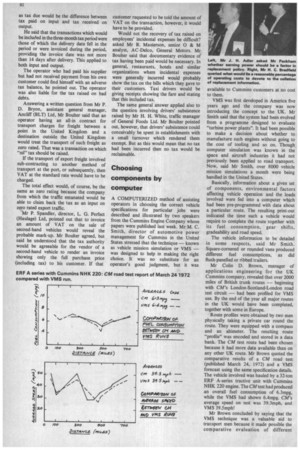Choosing components by computer
Page 84

Page 85

If you've noticed an error in this article please click here to report it so we can fix it.
A COMPUTERIZED method of assisting operators in choosing the correct vehicle specifications for particular jobs were described and illustrated by two speakers from the Cummins Engine Company whose papers were published last week. Mr M. C. Smith, director of automotive power management for Cummins in the United States stressed that the technique — known as vehicle mission simulation or VMS — was designed to help in making the right choice. It was no substitute for an operator's good judgment. but it was available to Cummins customers at no cost to them.
VMS was first developed in America five years ago and the company was now introducing the concept to the UK. Mr Smith said that the system had been evolved from a programme designed to evaluate "turbine power plants". It had been possible to make a decision about whether to manufacture such engines without going to the cost of tooling and so on. Though computer simulation was known in the space and aircraft industries it had not previously been applied to road transport. Now, said Mr Smith, over 8000 vehicle mission simulations a month were being handled in the United States.
Basically, information about a given set of components, environmental factors affecting vehicle operation and the loads involved were fed into a computer which had been pre-programmed with data about a particular route. The resulting print-out indicated the time such a vehicle would require to complete the route together with its fuel consumption, gear shifts, gradeability and road speed.
The vehicle information to be detailed in some respects. said Mr Smith. Square-cornered or rounded vans produced different fuel consumptions, as did flush-panelled or ribbed trailers.
Mr Colin D. Brown, manager of applications engineering for the UK Cummins company, revealed that over 2000 miles of British trunk routes — beginning with CM's London-Scotland-London road test circuit — had been profiled for VMS use. By the end of the year all major routes in the UK would have been completed. together with some in Europe.
Route profiles were obtained by two men physically taking a private car round the route. They were equipped with a compass and an altimeter. The resulting route "profile" was encoded and stored in a data bank. The CM test route had been chosen because it had more data available than on any other UK route. Mr Brown quoted the comparative results of a CM road test (published March 24, 1972) and a VMS forecast using the same specification details. The vehicle involved was hauled by a 32-ton ERF A-series tractive unit with Cummins NHK 220 engine. The CMtest had produced an overall fuel consumption of 6.3mpg, while the VMS had shown 6.4mpg. CM's average speed on test was 39.3mph, and VMS 39.5mph!
Mr Brown concluded by saying that the VMS technique was a valuable aid to transport men because it made possible the comparative evaluation of different
mmbinations of equipment without heavy :apital expenditure.
Time prevented a question and answer ;ession but both speakers indicated their ffillingness to answer written questions sent :o them c /o Cummins Engine Co Ltd, Coombe House, St George's Sq, New Malden, Surrey.








































































































































































































































